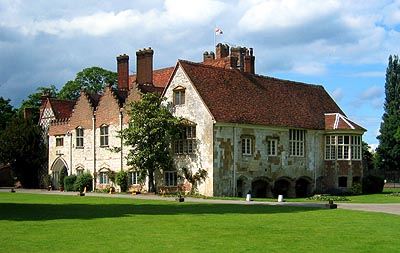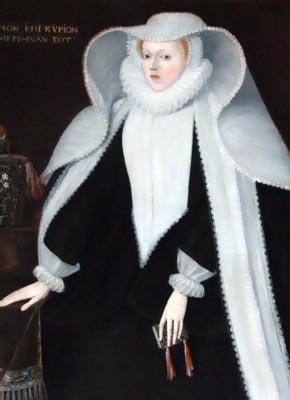 |
 |
|||
|
|
The last Abbot of Bisham was Abbot John Cordery. Actually, he was the only Abbot of Bisham. Founded by the 1st Earl of Salisbury as a Priory for Austin Canons, the community at Bisham was dissolved along with so many of England’s monastic houses in 1536. However, the unpredictable Henry VIII promptly refounded and upgraded it as a Benedictine Abbey. It only lasted six months. It would be impossible to ever prove whether Abbot Cordery did actually curse Bisham Abbey’s future inhabitants. However, an examination of these families show that misfortune has struck them with alarming regularity. Could it be just co-incidence?
Eventually the Abbey was bought by George Vansittart whose family fared little better. He was succeeded by his grandson and namesake who, having no children, was in turn succeeded by his cousin, Edward. Here was the first direct succession when Sir Henry inherited from his father. However, the latter’s son died at Eton College at the tender age of fourteen. The house was finally sold after the death of Sir Henry’s daughter, Phyllis, in 1958. Both her heirs, her nephews, had been killed in the Second World War, and the Sports Council took on the estate as a memorial to them. Romantic though the curse is, it may well have been invented earlier this century to explain actual events. Lady Hoby’s hauntings of Bisham are a little more certain than the reasons for them. The Abbey is known to be one of the most haunted houses in Britain, certainly the most haunted in Berkshire. Lady Hoby’s best known appearance was to Admiral Edward W. Vansittart, when she stepped down from her portrait to stand beside him. She has appeared before other guests: tearing curtains from beds, throwing things around rooms, and threatening to strike them bald! Usually, however, her appearances are more sedate. Her Ladyship materialises in the negative, with black face and white clothes. She always washes her hands, yet her miraculous fountain must be rather indistinct, for in recent years people have claimed it to be a floating basin of water. More often than not though, it is merely her sobbing that is heard, or a light seen in the empty Tower Room. She was once seen by some young boys in a boat down by the river, and some even believe she is responsible for the mists which often envelope the Abbey, drawing the most unwilling of passers-by into the depths of the Thames.
Which of Elizabeth Hoby’s sons are we really talking about though? He is usually named as William, Lady Hoby’s youngest son. However, no William appears in recognised genealogies. Elizabeth Hoby was the daughter of Sir Anthony Cooke, one of four sisters celebrated for their great learning, as the story suggests. She married Thomas Hoby, the English Ambassador to the French Court in 1557. One of her sisters married Sir Nicholas Bacon, the Lord Keeper, and another married Sir William Cecil, Lord Burghley, the Lord High Treasurer. By all accounts she was indeed proud and ambitious, and keen for her children to have a good education. She and Sir Thomas had three children before the latter’s death in 1566, Edward, Elizabeth and Anne, and one born very shortly afterwards, known therefore as Thomas Posthumous; but there was no William in the family. In 1574 the ambitious lady remarried to the Earl of Bedford’s son, John, Lord Russell, and though she had three further children, Elizabeth, Anne & Francis, still there was no William. Did he really exist, or is the story merely fable as so many insist? It is quite feasible to suppose that little William did exist, even though no definite record of him has been found. He does no appear in the Bisham baptismal registers, but both Hobys and Russells held other estates on which a son could have been born and christened. Not all records have survived from those far off days not long after parish registers began (1538), and many children’s entries were missed from the register at that time anyway. Dame Hoby would not even have had to have instigated a cover up to hide her son’s very existence as some have suggested. Though I’m sure she could have done it. A small child buried three hundred years ago would leave little behind him. Only the memory of him passed down by generations of Bisham folk. "Proof" of William’s existence is provided by a strange event which took place at the Abbey in 1840. The house had been let to a Mrs.East at the time. This lady decided to have some builders in to make some alterations to the shutters in the Dining Room. The quoins on the windows were cut down, causing the corner to give way. So the workmen had to take up some of the floorboards in order to rebuild it. Between the joists they discovered large quantities of paper and other rubbish, including copy books. Mrs.General Vansittart was immediately sent for, and she drove over with her sister-in-law to see them. The books contained the writings of many members of the Hoby family with corrections by the wicked lady herself. One, Mrs.Vansittart later remembered, had a blot on nearly every page and bore, she believed, the name of William Hoby! When leaving, Mrs.Vansittart had wanted to take two or three of the books with her, but her sister-in-law felt that they should wait until Admiral Vansittart had examined the books before removing any. On their return, however, the copy books had disappeared. Apparently the workmen had thought they might be worth something, and so had taken the books away with them. Convenient though the loss of the copy books was, the fact that they existed is beyond doubt, for the above events were recorded in detail by Mrs.Vansittart shortly after they happened. It is Mrs.Vansittart’s memory, however, that we might question. After all she only ever said that she thought the name on the blotted books had been "William Hoby". Early versions of the legend do not mention a Christian name for the lad. It, therefore, seems probable that the name William stems from this discovery in the mid nineteenth century. When given a surname the boy is always a Hoby, yet the fact that William was said to be Lady Hoby’s youngest son is totally contradicts this. Her youngest son was a Russell and her youngest Hoby son was most definitely Thomas Posthumous, born after his father’s death. It is possible that the boy’s surname may have been transferred direct from his mother who is always referred to as Lady Hoby rather than Lady Russell. Though it was not unusual, her actual youngest son, Francis Russell, did in fact die at a young age in unknown circumstances. Could he have been the so called "William"? Alternatively, the story may be an exaggeration of Thomas Posthumous’ early life. Dame Elizabeth is known to have written to her brother-in-law, Lord Burghley, telling him of trouble that she was having with Thomas over his lessons. Lord Burghley’s response is unknown. Perhaps he urged her to wield a heavy ruler! Who can say? The
Story
|
|||
| © Nash Ford Publishing 2001. All Rights Reserved. | ||||



 Soon
after the dissolution of the monasteries, the Countess of Salisbury managed
to get back many of her family’s lands in Bisham, including the Abbey.
Both she and many of her children lost their heads during Tudor attempts to
exterminate the last of the Plantagenets. Her lands were confiscated and
later Bisham was given to the unfortunate Anne of Cleves, Henry VIII’s
fourth wife, who swapped it, for Westhorpe in Suffolk, with
Soon
after the dissolution of the monasteries, the Countess of Salisbury managed
to get back many of her family’s lands in Bisham, including the Abbey.
Both she and many of her children lost their heads during Tudor attempts to
exterminate the last of the Plantagenets. Her lands were confiscated and
later Bisham was given to the unfortunate Anne of Cleves, Henry VIII’s
fourth wife, who swapped it, for Westhorpe in Suffolk, with  Up until 1936, Lady
Hoby had apparently materialised at Bisham during every coronation since at
least that of Charles I. However, latterly she appears to have missed her
regular appointment even though she still haunts the building on other
occasions. Perhaps she has been put off by Edward VIII’s abdication.
Whatever the reason it seems she no longer appears on Royal occasions to
atone for the loss of her son.
Up until 1936, Lady
Hoby had apparently materialised at Bisham during every coronation since at
least that of Charles I. However, latterly she appears to have missed her
regular appointment even though she still haunts the building on other
occasions. Perhaps she has been put off by Edward VIII’s abdication.
Whatever the reason it seems she no longer appears on Royal occasions to
atone for the loss of her son.